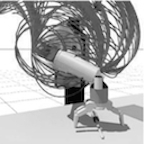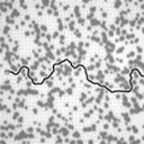My work spans several domains of robotics and artificial intelligence. A common thread of my investigations involves the development of computationally efficient algorithms that enable robots to make more informed decisions by exploiting sophisticated predictive models. Below is a brief sample of my research.
Natural Language Understanding of Robot Instructions
 After several years of studying how best to search the continuum of actions for the best possible motions, I became interested in how planning problems emerge from interactions and observations between the robot and the environment. Rather than rely on intermediate layers of autonomy architectures to translate instructions into constraints and cost functions, I am seeking to develop techniques that identify the formulation of trajectory planning problems directly from unstructured natural language. Recently I developed a technique that uses probabilistic graphical models trained with a corpus of labeled examples to determine the constraint set that best represents a given command, thereby avoiding computational bottlenecks imposed by search in a state-action space for the most probable path.
After several years of studying how best to search the continuum of actions for the best possible motions, I became interested in how planning problems emerge from interactions and observations between the robot and the environment. Rather than rely on intermediate layers of autonomy architectures to translate instructions into constraints and cost functions, I am seeking to develop techniques that identify the formulation of trajectory planning problems directly from unstructured natural language. Recently I developed a technique that uses probabilistic graphical models trained with a corpus of labeled examples to determine the constraint set that best represents a given command, thereby avoiding computational bottlenecks imposed by search in a state-action space for the most probable path.
Selected Publications
F. Duvallet, M. Walter, T.M. Howard, S. Hemachandra, J. Oh, S. Teller, N. Roy, and A. Stentz, "A Probabilistic Framework for Inferring Maps and Behaviors from Natural Language", to appear in the Proceedings of the 14th International Symposium on Experimental Robotics, 2014.
T.M. Howard, S. Tellex, and N. Roy, "A Natural Language Planner Interface for Mobile Manipulators," to appear in the Proceedings of the 2014 International Conference on Robotics and Automation, 2014. [paper]
Dexterous Manipulation
 Several challenges for dexterous manipulation include coordination of many degrees of freedom, modeling of interactions between objects and end-effectors, and effective techniques for human-robot interaction. I applied the concepts behind model-predictive trajectory generation of mobile robots for mobile manipulators by augmenting the space of parameterized action sequences with degrees of freedom of the manipulator. This was used as part of a supervised teleoperation system for a mobile manipulator designed to improve the efficiency and reduce the cognitive load of human operators. I later extended this technique for coordinated planning of a robot arm, hand, and neck as motion planning lead of the JPL/Caltech team during Phase I of the DARPA Autonomous Robotic Manipulation program.
Several challenges for dexterous manipulation include coordination of many degrees of freedom, modeling of interactions between objects and end-effectors, and effective techniques for human-robot interaction. I applied the concepts behind model-predictive trajectory generation of mobile robots for mobile manipulators by augmenting the space of parameterized action sequences with degrees of freedom of the manipulator. This was used as part of a supervised teleoperation system for a mobile manipulator designed to improve the efficiency and reduce the cognitive load of human operators. I later extended this technique for coordinated planning of a robot arm, hand, and neck as motion planning lead of the JPL/Caltech team during Phase I of the DARPA Autonomous Robotic Manipulation program.
Selected Publications
D. Anderson, T.M. Howard, D. Apfelbaum, H. Herman, and A. Kelly, "Coordinated Control and Range Imaging for Mobile Manipulation," in Proceedings of the 11th International Symposium on Experimental Robotics, 2008, pp. 547-556. [paper]
N. Hudson, T.M. Howard, J. Ma, A. Jain, M. Bajracharya, S. Myint, C. Kuo, L. Matthies, P. Backes, P. Hebert, T. Fuchs, and J. Burdick, "End-to-End Dexterous Manipulation with Deliberate Interactive Estimation," in Proceedings to the 2012 International Conference on Robotics and Automation, 2012. [paper]
Mobile Robot Navigation
 The fundamental challenge of robot navigation involves making optimal decisions under temporal and computational resource constraints. I began work in the topic by developing efficient algorithms for navigation search space design through intelligent sampling of boundary states in both constrained and unstructured environments. I applied this technique for autonomous in-lane navigation as a member of Tartan Racing on Boss, winner of the 2007 DARPA Urban Challenge. I later addressed difficulties around following of paths with geometric singularities (turn-in-place) and discontinuities (cusps and multi-point turns) using unconstrained optimization trajectory generation with parameterized action sequences initialized by a regional motion planner.
The fundamental challenge of robot navigation involves making optimal decisions under temporal and computational resource constraints. I began work in the topic by developing efficient algorithms for navigation search space design through intelligent sampling of boundary states in both constrained and unstructured environments. I applied this technique for autonomous in-lane navigation as a member of Tartan Racing on Boss, winner of the 2007 DARPA Urban Challenge. I later addressed difficulties around following of paths with geometric singularities (turn-in-place) and discontinuities (cusps and multi-point turns) using unconstrained optimization trajectory generation with parameterized action sequences initialized by a regional motion planner.
Selected Publications
T.M. Howard, C. Green, D. Ferguson, and A. Kelly, "State Space Sampling of Feasible Motions for High Performance Mobile Robot Navigation in Complex Environments," Journal of Field Robotics, vol. 25, no. 6-7, pp. 325-345, June-July 2008. [paper]
D. Ferguson, T.M. Howard, and M. Likhachev, "Motion Planning in Urban Environments," Journal of Field Robotics, vol. 25, no. 11-12, pp. 939-960, November-December 2008. [paper]
T.M. Howard, C.J. Green, and A. Kelly, "Receding Horizon Model-Predictive Control for Mobile Robot Navigation of Intricate Paths," in Proceedings of the 7th International Symposium on Field and Service Robotics, 2009. [paper]
Model-Predictive Motion Planning
 Robots need to understand the consequences of their own actions in order to make informed decisions about safety and optimality of candidate motions. My work in this area has primarily focused on the development and application of techniques that invert arbitrarily complex models of motion and environmental interaction, with particular attention to terrain shape and wheel-terrain interaction. I later demonstrated that this method could be applied for predictive compensation of impaired mobility through experiments of a planetary rover with a disabled drive motor. My thesis work presented an algorithm that adapts coarse recombinant motion planning search spaces to the local environment to improve the relative optimality and computational efficiency of planning in complex environments.
Robots need to understand the consequences of their own actions in order to make informed decisions about safety and optimality of candidate motions. My work in this area has primarily focused on the development and application of techniques that invert arbitrarily complex models of motion and environmental interaction, with particular attention to terrain shape and wheel-terrain interaction. I later demonstrated that this method could be applied for predictive compensation of impaired mobility through experiments of a planetary rover with a disabled drive motor. My thesis work presented an algorithm that adapts coarse recombinant motion planning search spaces to the local environment to improve the relative optimality and computational efficiency of planning in complex environments.
Selected Publications
T.M. Howard and A. Kelly, "Optimal Rough Terrain Trajectory Generation for Wheeled Mobile Robots," International Journal of Robotics Research, vol. 26, no. 2, pp. 141-166, February 2007. [paper]
M. Pivtoraiko, T.M. Howard, I. Nesnas, and A. Kelly, "Field Experiments in Rover Navigation via Model-Based Trajectory Generation and Nonholonomic Motion Planning in State Lattices," in Proceedings of the 9th International Symposium on Artificial Intelligence, Robotics, and Automation in Space, 2008. [paper]
T.M. Howard, "Adaptive Model-Predictive Motion Planning for Navigation in Complex Environments," Ph.D. Dissertation, Robotics Institute, Carnegie Mellon University, Pittsburgh, PA, 2009. [paper]
 After several years of studying how best to search the continuum of actions for the best possible motions, I became interested in how planning problems emerge from interactions and observations between the robot and the environment. Rather than rely on intermediate layers of autonomy architectures to translate instructions into constraints and cost functions, I am seeking to develop techniques that identify the formulation of trajectory planning problems directly from unstructured natural language. Recently I developed a technique that uses probabilistic graphical models trained with a corpus of labeled examples to determine the constraint set that best represents a given command, thereby avoiding computational bottlenecks imposed by search in a state-action space for the most probable path.
After several years of studying how best to search the continuum of actions for the best possible motions, I became interested in how planning problems emerge from interactions and observations between the robot and the environment. Rather than rely on intermediate layers of autonomy architectures to translate instructions into constraints and cost functions, I am seeking to develop techniques that identify the formulation of trajectory planning problems directly from unstructured natural language. Recently I developed a technique that uses probabilistic graphical models trained with a corpus of labeled examples to determine the constraint set that best represents a given command, thereby avoiding computational bottlenecks imposed by search in a state-action space for the most probable path.
 Several challenges for dexterous manipulation include coordination of many degrees of freedom, modeling of interactions between objects and end-effectors, and effective techniques for human-robot interaction. I applied the concepts behind model-predictive trajectory generation of mobile robots for mobile manipulators by augmenting the space of parameterized action sequences with degrees of freedom of the manipulator. This was used as part of a supervised teleoperation system for a mobile manipulator designed to improve the efficiency and reduce the cognitive load of human operators. I later extended this technique for coordinated planning of a robot arm, hand, and neck as motion planning lead of the JPL/Caltech team during Phase I of the DARPA Autonomous Robotic Manipulation program.
Several challenges for dexterous manipulation include coordination of many degrees of freedom, modeling of interactions between objects and end-effectors, and effective techniques for human-robot interaction. I applied the concepts behind model-predictive trajectory generation of mobile robots for mobile manipulators by augmenting the space of parameterized action sequences with degrees of freedom of the manipulator. This was used as part of a supervised teleoperation system for a mobile manipulator designed to improve the efficiency and reduce the cognitive load of human operators. I later extended this technique for coordinated planning of a robot arm, hand, and neck as motion planning lead of the JPL/Caltech team during Phase I of the DARPA Autonomous Robotic Manipulation program.
 The fundamental challenge of robot navigation involves making optimal decisions under temporal and computational resource constraints. I began work in the topic by developing efficient algorithms for navigation search space design through intelligent sampling of boundary states in both constrained and unstructured environments. I applied this technique for autonomous in-lane navigation as a member of
The fundamental challenge of robot navigation involves making optimal decisions under temporal and computational resource constraints. I began work in the topic by developing efficient algorithms for navigation search space design through intelligent sampling of boundary states in both constrained and unstructured environments. I applied this technique for autonomous in-lane navigation as a member of  Robots need to understand the consequences of their own actions in order to make informed decisions about safety and optimality of candidate motions. My work in this area has primarily focused on the development and application of techniques that invert arbitrarily complex models of motion and environmental interaction, with particular attention to terrain shape and wheel-terrain interaction. I later demonstrated that this method could be applied for predictive compensation of impaired mobility through experiments of a planetary rover with a disabled drive motor. My thesis work presented an algorithm that adapts coarse recombinant motion planning search spaces to the local environment to improve the relative optimality and computational efficiency of planning in complex environments.
Robots need to understand the consequences of their own actions in order to make informed decisions about safety and optimality of candidate motions. My work in this area has primarily focused on the development and application of techniques that invert arbitrarily complex models of motion and environmental interaction, with particular attention to terrain shape and wheel-terrain interaction. I later demonstrated that this method could be applied for predictive compensation of impaired mobility through experiments of a planetary rover with a disabled drive motor. My thesis work presented an algorithm that adapts coarse recombinant motion planning search spaces to the local environment to improve the relative optimality and computational efficiency of planning in complex environments.